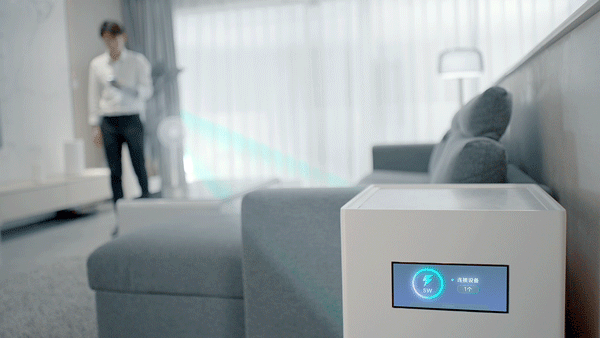Credit: Xiaomi
The multinational electronics company Xiaomi announced the development of a new power transmission system that can charge a cellphone from across a room without any wires or charging pads.
The Mi Air Charge Technology, still in development, is capable of providing 5 watts of power to a device around 16 feet away. Transmission is unaffected by physical objects between transmission and receiving points.
As a company blog posted on its web site stated today, "The core technology of Xiaomi's remote charging lies in space positioning and energy transmission."
The charging base is composed of an array of 144 antennas that utilize beamforming to send millimeter-wide waves directly to a cellphone or other device. Beamforming creates wireless signals that are aimed towards a specific device to achieve a faster, more reliable and more direct connection. Traditional wireless signals disperse waves to reach multiple devices over a wide area.
Devices such as smartphones capture the waves and convert them into power. Beacon antennas on the devices to be charged emit low-power signals allowing the charging station to pinpoint their location. A 14-antenna receiving array captures and converts the waves into power.
Multiple devices can be charged simultaneously.
Miami says it hopes to soon broaden the reach of Mi Air Charge Technology.
"In the near future," Xiaomi says, its "self-developed space isolation charging technology will also be able to work with smart watches, bracelets and other wearable devices."
"Soon our living room devices, including speakers, desk lamps and other small smart home products, will all be built upon a wireless power supply design, completely free of wires, making our living rooms truly wireless," Xiaomi says.
The concept of modern wireless charging was introduced in 2009 as Palm Inc. unveiled its wireless Touchstone charger for use with its popular Palm personal digital assistant. Those devices were the first widely used handheld computers and helped usher in cellphone technology.
A technology similar to Mi Air Charge was introduced in 2015 by tech firm Energous, which claimed its WattUp technology could charge phones up to 15 feet away. It used a combination of radio frequency and Bluetooth connections to identify and contact receiving-chip embedded devices to be charged. Its prototypes did not exceed 70 percent efficiency and the product was never brought to market.
The first known use of wireless power transfer technology was 127 years ago as inventors M. Hutin and M. Le-Blanc introduced an electric vehicle. But competitor combustion engines gained wide acceptance and electric vehicles, especially cars, would not gain serious attention until more than a century later.
Xiaomi is noted for its highly regarded Mi series cellphones. In 2014, its Xiaomi Mi 3 held the title as the fastest Android smartphone. And while the Apple iPhone 12 boasted a groundbreaking 15-watt MagSafe wireless charging staton last year that could fully charge a phone in a half hour, Xiaomi at the same time unveiled an 80-watt that could complete the job in 19 minutes.
The Mi Air Charge Technology is not expected to be available before 2022.
More information: blog.mi.com/en/2021/01/29/forg … r-charge-technology/
© 2021 Science X Network
























